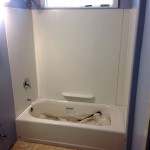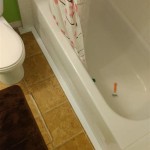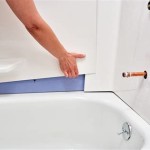Can You Cover An Existing Bathtub? Exploring Options and Considerations
The question of whether an existing bathtub can be covered is a common one, particularly among homeowners seeking bathroom renovations without the extensive demolition typically associated with bathtub replacement. The answer is nuanced and depends heavily on the goals of the project, the condition of the existing bathtub, and the budget allocated for the undertaking. Numerous methods exist to cover or modify an existing bathtub, each with its own set of advantages and disadvantages. This article explores these options in detail, outlining the procedures, potential issues, and factors to consider when deciding to cover an existing bathtub.
Bathtub Liners: A Common Covering Solution
One of the most frequently employed methods for covering an existing bathtub is the installation of a bathtub liner. A bathtub liner is a custom-molded acrylic or PVC sheet that fits precisely over the existing bathtub. This solution offers a relatively quick and less disruptive alternative to full bathtub replacement. The process generally involves a professional taking detailed measurements of the existing bathtub. These measurements are then used to fabricate a liner that is specifically designed to fit the existing bathtub's dimensions and shape. Once the liner is manufactured, it is typically installed by gluing it over the cleaned and prepared surface of the existing bathtub.
The primary advantage of using a bathtub liner is the speed of installation. In many cases, a bathtub liner can be installed in a single day, minimizing disruption to the household. Additionally, bathtub liners often come with antimicrobial coatings that resist mold and mildew growth, contributing to a cleaner and healthier bathroom environment. Furthermore, liners can be manufactured in a variety of colors and styles, allowing homeowners to update the aesthetic of their bathroom without the expense and hassle of a complete replacement. However, there are several important considerations to keep in mind when considering a bathtub liner.
The underlying condition of the existing bathtub is crucial. If the existing bathtub has significant structural damage, such as cracks or leaks, simply covering it with a liner will not address the underlying problem. In such cases, the liner may actually trap moisture, leading to further deterioration and potential mold growth between the liner and the original tub. Therefore, a thorough inspection of the existing bathtub is essential before proceeding with liner installation. Any structural issues must be addressed before the liner is installed. This may involve repairs to the existing bathtub, which can add to the overall cost.
Another potential issue with bathtub liners is the possibility of a hollow sound when the bathtub is used. This phenomenon can occur if there are gaps between the liner and the original bathtub, particularly in areas where the original bathtub is not perfectly level or if the adhesive used is not applied adequately. While this does not necessarily affect the functionality of the bathtub, it can be aesthetically unappealing. Opting for a reputable installer with experience can minimize this risk.
The cost of bathtub liners can vary depending on the size and shape of the bathtub, the material used for the liner, and the complexity of the installation. While generally less expensive than a full bathtub replacement, liners can still represent a significant investment, so obtaining multiple quotes and comparing warranties is prudent.
Bathtub Refinishing or Reglazing: A Surface Treatment Option
Bathtub refinishing, also known as reglazing or resurfacing, is another method for improving the appearance of an existing bathtub without replacing it entirely. This process involves applying a new coating to the surface of the bathtub, effectively restoring its original luster and covering up any imperfections, such as scratches, chips, or stains. Bathtub refinishing is typically a more cost-effective solution than installing a bathtub liner or replacing the entire bathtub. However, it is essential to understand the procedure and its limitations before opting for this method.
The refinishing process typically begins with thorough cleaning and preparation of the existing bathtub surface. This may involve removing any loose paint or rust, repairing minor chips or cracks, and etching the surface to ensure proper adhesion of the new coating. Once the surface is prepared, multiple coats of a specialized epoxy or acrylic coating are applied. These coatings are designed to be durable and resistant to water, chemicals, and scratches. The entire process usually takes a few days, including drying time.
A key advantage of bathtub refinishing is its affordability. It is generally significantly less expensive than bathtub liners or full replacement. Additionally, refinishing can be completed relatively quickly, minimizing disruption to the bathroom. Refinishing also allows for customization options, such as changing the color of the bathtub. However, refinishing is not a permanent solution. The lifespan of a refinished bathtub depends on the quality of the materials used, the skill of the technician, and the care taken by the homeowner. With proper care, a refinished bathtub can last for several years.
One of the potential drawbacks of bathtub refinishing is the strong odor associated with the chemicals used in the process. Proper ventilation is essential during and after refinishing to mitigate this issue. Furthermore, the surface of a refinished bathtub can be more susceptible to scratches and chips than a new bathtub or a bathtub liner. Therefore, careful cleaning and maintenance are required to prolong the lifespan of the refinished surface. The preparation process is also critical. A poorly prepared surface can lead to premature peeling and bubbling of the new coating.
The durability of the refinished surface is highly dependent on the skill of the technician performing the work. It is essential to choose a reputable and experienced refinishing company that uses high-quality materials and follows proper application procedures. Checking online reviews and asking for references can help to ensure that the refinishing is done correctly.
Alternative Covering Methods and Considerations
While bathtub liners and refinishing are the most common methods for covering an existing bathtub, other options exist, though they may be less frequently used or more specialized. These alternatives often involve more extensive modifications to the bathroom and can be more expensive than liners or refinishing. However, they may be appropriate in certain situations, particularly when the goal is to create a custom bathroom design.
One option is to build a surround around the existing bathtub. This involves constructing a frame around the bathtub and covering it with tile, stone, or other decorative materials. This approach can completely transform the appearance of the bathtub and integrate it seamlessly into the overall bathroom design. However, building a surround requires significant carpentry and tiling skills, and it can be a time-consuming and expensive project. It also necessitates ensuring the existing bathtub is structurally sound before proceeding with construction.
Another possibility is to encase the existing bathtub within a custom-built enclosure. This can involve creating a tiled or paneled structure that conceals the entire bathtub, with access provided through a door or removable panel. This method offers a high degree of design flexibility and can be used to create a unique and luxurious bathing experience. However, it requires careful planning and execution to ensure that the enclosure is functional, aesthetically pleasing, and properly waterproofed.
A less common, but potentially viable option, is to convert the existing bathtub into a shower. This involves removing the existing bathtub and replacing it with a shower base. While this does not technically cover the bathtub, it effectively eliminates the need to deal with its appearance. Converting a bathtub to a shower can be a good option for homeowners who rarely use the bathtub and prefer a shower. This requires plumbing modifications and waterproofing, and it can be a more involved project than simply covering the bathtub.
Before undertaking any of these alternative covering methods, it is crucial to assess the structural integrity of the existing bathtub and the surrounding bathroom. Any underlying damage, such as water leaks or mold growth, must be addressed before proceeding with the project. Additionally, it is important to consider the impact of the covering method on the long-term maintenance and value of the bathroom. While covering an existing bathtub can be a cost-effective way to update its appearance, it is essential to ensure that the covering method is durable, aesthetically pleasing, and does not create any unforeseen problems.
In conclusion, determining whether to cover an existing bathtub requires careful consideration of several factors, including the condition of the existing bathtub, the desired aesthetic, the budget, and the long-term maintenance requirements. Bathtub liners and refinishing are the most common and often the most practical options for covering an existing bathtub, but alternative methods may be appropriate in certain situations. A thorough assessment of the existing conditions and a clear understanding of the available options are essential for making an informed decision.

How To Make A Beautiful Removable Bathtub Cover

How To Remove And Replace A Bathtub The Home Depot

How To Refinish An Old Clawfoot Bath Tub

Bathtub Remodel Ideas Surrounds Houselogic Bathroom Tips

Update An Old Bathtub In Three Easy Steps The Chronicles Of Home Diy Bathroom Remodel

Hemlock Walk In Bathtubs Modernize Your Bathroom Enhance Life

How To Remove And Replace A Bathtub The Home Depot
How Hard Is It To Install A New Bathtub Over An Existing On Your Own Quora

How Do You Remove An Old Bathtub Bathwraps

How To Install A Delta Acrylic Bathtub Quick Tips
Related Posts








